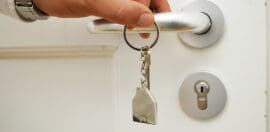A HomeSeeker Package could end homelessness in Australia for good

2 September 2020 at 6:30 pm
Ending rough sleeping homelessness is not a pipe-dream – but it needs leadership, writes David Pearson, CEO of the Australian Alliance to End Homelessness.
During the COVID-19 pandemic we have seen unprecedented support from governments and communities across Australia to help people sleeping rough. These collective efforts have been pronominal and effective, supporting over 16,000 households, including individuals and families, into housing.
Just a few weeks ago, the Dan Andrews government announced a massive $150 million for a From Homelessness to a Home package, which will support over 2,000 Victorians to break the cycle of rough sleeping homelessness and transition into stable, long-term housing. It follows a record $36 million investment in NSW with their Together Home package.
It’s self-evident that in a pandemic, you cannot practice social distancing, good hygiene or follow public health directives to stay home if you are unwell if you do not have a home. The same applies for people who are in overcrowded homes.
These investments from state governments in addressing homelessness are welcome. But alone they will not solve the problem of homelessness, something that is eminently achievable and which is happening in a growing number of communities internationally. Thirteen communities in the USA and Canada have ended chronic and/or veterans rough sleeping and a further 50 have achieved significant reductions.
There is nothing normal about rough sleeping, we shouldn’t accept it. Rough sleeping is one of the most visible manifestations of inequality in our society. Yet contrary to popular understanding it is cheaper to solve the problem than to leave it unaddressed. It makes no sense economically or morally. When people sleep rough, they are on average likely to die up to 30 years younger than those of us with a home.
That’s why The Australian Alliance to End Homelessness (AAEH) is calling on the federal government for a comprehensive and national coordinated Rough Sleeping Homelessness Pandemic Response Plan – or put more simply a HomeSeeker package – to end rough sleeping homelessness in Australia for good.
This HomeSeeker package must ensure that people in hotels are not kicked out back onto the streets or fall out because of a lack of appropriate supports – as is already happening. It must build more social housing, but importantly include the support to go with it for the most vulnerable, particularly support which meets their health needs.
Such a package must also include support for community-led efforts to better coordinate the service systems that exist to help people sleeping rough. Afterall, these kinds of community-driven Housing First approaches are what has led to the success we are seeing in North America.
The AAEH is a community focused on the implementation of these approaches in Australia. We recognise that the scale of homelessness in Australia is both preventable and solvable, and we are committed and working to ensure that any incidents of homelessness that do occur are rare, brief and non-recurring. That is how we define an end to homelessness.
There are a number of communities across Australia implementing a Zero Homelessness Methodology – including Brisbane, Adelaide, Perth, Melbourne and Sydney. The method starts with understanding the names and needs of every person sleeping rough in a community – something that most communities shockingly don’t know. From this, these communities have created what’s called a by-name list and use that list to better coordinate and triage the scarce resources in that community for those most in need.
We need more investment in housing and homelessness services, but we also need to improve the way these and other services are coordinated. It is naive to think that to end homelessness all we need is more investment in what we are already doing. There is always a need for innovation and improvement.
That’s why the communities leading the implementation of this Zero Homelessness Methodology in Australia are seeking to do both – advocating for more investment and setting about implementing a quality improvement process that has been successfully used elsewhere to end homelessness.
This quality improvement process is adapted from successful efforts to reduce infections in health care settings but, in the homelessness context, it’s used to close the gaps in the support systems that for decades have seen so many of our most vulnerable citizens slip through.
Ending homelessness is possible, but not without leadership. Unfortunately, for too many of us, we have become desensitised to this issue. To see people sleeping on the streets and in parks as normal, inevitable and intractable. It is anything but, and our response to COVID-19 shows that. On any given night there are about 8,200 people sleeping rough in Australia and so far we estimate that 7,000 people have been temporarily sheltered since the crisis began.
There has never been a better time to seek an end to rough sleeping homelessness in Australia than right now. We have an opportunity to lift the social safety net in Australia off the street – permanently. To achieve this, we need the Commonwealth government to take urgent action now and to help communities build back better by implementing a HomeSeeker package of support and targeted investments.







